TOYOTA PRIUS 2010 3.G Owners Manual
Manufacturer: TOYOTA, Model Year: 2010, Model line: PRIUS, Model: TOYOTA PRIUS 2010 3.GPages: 616, PDF Size: 10.45 MB
Page 251 of 616
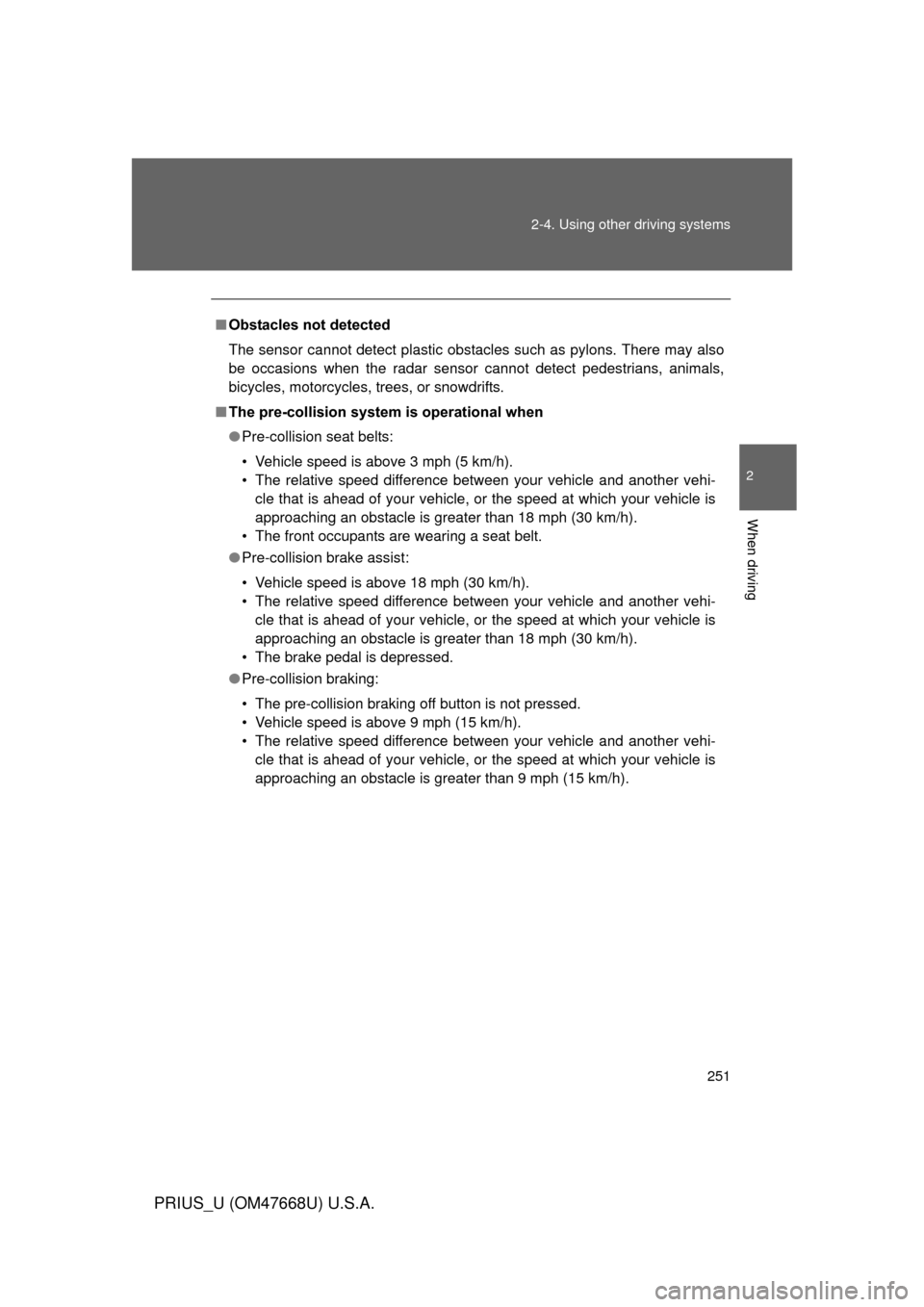
251
2-4. Using other
driving systems
2
When driving
PRIUS_U (OM47668U) U.S.A.
■Obstacles not detected
The sensor cannot detect plastic obstacles such as pylons. There may also
be occasions when the radar sensor cannot detect pedestrians, animals,
bicycles, motorcycles, trees, or snowdrifts.
■ The pre-collision system is operational when
● Pre-collision seat belts:
• Vehicle speed is above 3 mph (5 km/h).
• The relative speed difference between your vehicle and another vehi-
cle that is ahead of your vehicle, or the speed at which your vehicle is
approaching an obstacle is greater than 18 mph (30 km/h).
• The front occupants are wearing a seat belt.
● Pre-collision brake assist:
• Vehicle speed is above 18 mph (30 km/h).
• The relative speed difference between your vehicle and another vehi-
cle that is ahead of your vehicle, or the speed at which your vehicle is
approaching an obstacle is greater than 18 mph (30 km/h).
• The brake pedal is depressed.
● Pre-collision braking:
• The pre-collision braking off button is not pressed.
• Vehicle speed is above 9 mph (15 km/h).
• The relative speed difference between your vehicle and another vehi-
cle that is ahead of your vehicle, or the speed at which your vehicle is
approaching an obstacle is greater than 9 mph (15 km/h).
Page 252 of 616

252 2-4. Using other driving systems
PRIUS_U (OM47668U) U.S.A.
■Conditions that may trigger the system even if there is no danger of
collision
● When there is an object by the roadside at the entrance to a curve
● When passing an oncoming vehicle on a curve
● When driving over a narrow iron bridge
● When there is a metal object on the road surface
● When driving on an uneven road surface
● When passing an oncoming vehicle on a left-turn
● When your vehicle rapidly closes on the vehicle in front
When the system is activated in the situations described above there is also
a possibility that the seat belts will retract quickly and the brakes will be
applied with a force greater than normal. When the seat belt is locked in the
restricted position, stop the vehicle in a safe place, release the seat belt and
refasten.
■ When there is a malfunction in the system
Warning lights and/or warning messages will turn on or flash. ( P. 508)
Page 253 of 616

253
2-4. Using other
driving systems
2
When driving
PRIUS_U (OM47668U) U.S.A.
■Certification
For vehicles sold in the U.S.A.
FCC ID: HYQDNMWR004
FCC WARNING
Changes or modifications not expressly approved by the party responsi-
ble for compliance could void the user’s authority to operate the equip-
ment.
FCC RF exposure Information
This device complies with the FCC RF exposure requirements.
This device complies with Part 15 of the FCC Rules and RSS-210. Oper-
ation is subject to the following two conditions: (1) this device may not
cause harmful interference, and (2) this device must accept any interfer-
ence received, including interference that may cause undesired opera-
tion.
For vehicles sold in Canada
Operation is subject to the following two conditions: (1) this device may
not cause interference, and (2) this device must accept any interference,
including interference that may cause undesired operation of the device.
Page 254 of 616

254 2-4. Using other driving systems
PRIUS_U (OM47668U) U.S.A.
CAUTION
■Handling the radar sensor
Observe the following to ensure the pre-collision system can function effec-
tively.
● Keep the sensor and grille cover clean at all time.
Clean the sensor and grille cover with a soft cloth so you do not mark or
damage them.
● Do not subject the sensor or surrounding area to a strong impact.
If the sensor moves even slightly off position, the system may malfunction.
If the sensor or surrounding area is subject to a strong impact, always
have the area inspected and adjusted by your Toyota dealer.
● Do not disassemble the sensor.
● Do not attach accessories or stickers to the sensor, grille cover or sur-
rounding area.
● Do not modify or paint the sensor and grille cover.
■ Limitations of the pre-collision system
Do not rely on the pre-collision system. Always drive safely, taking care to
observe your surroundings and checking for any obstacles or other road
hazards.
Page 255 of 616
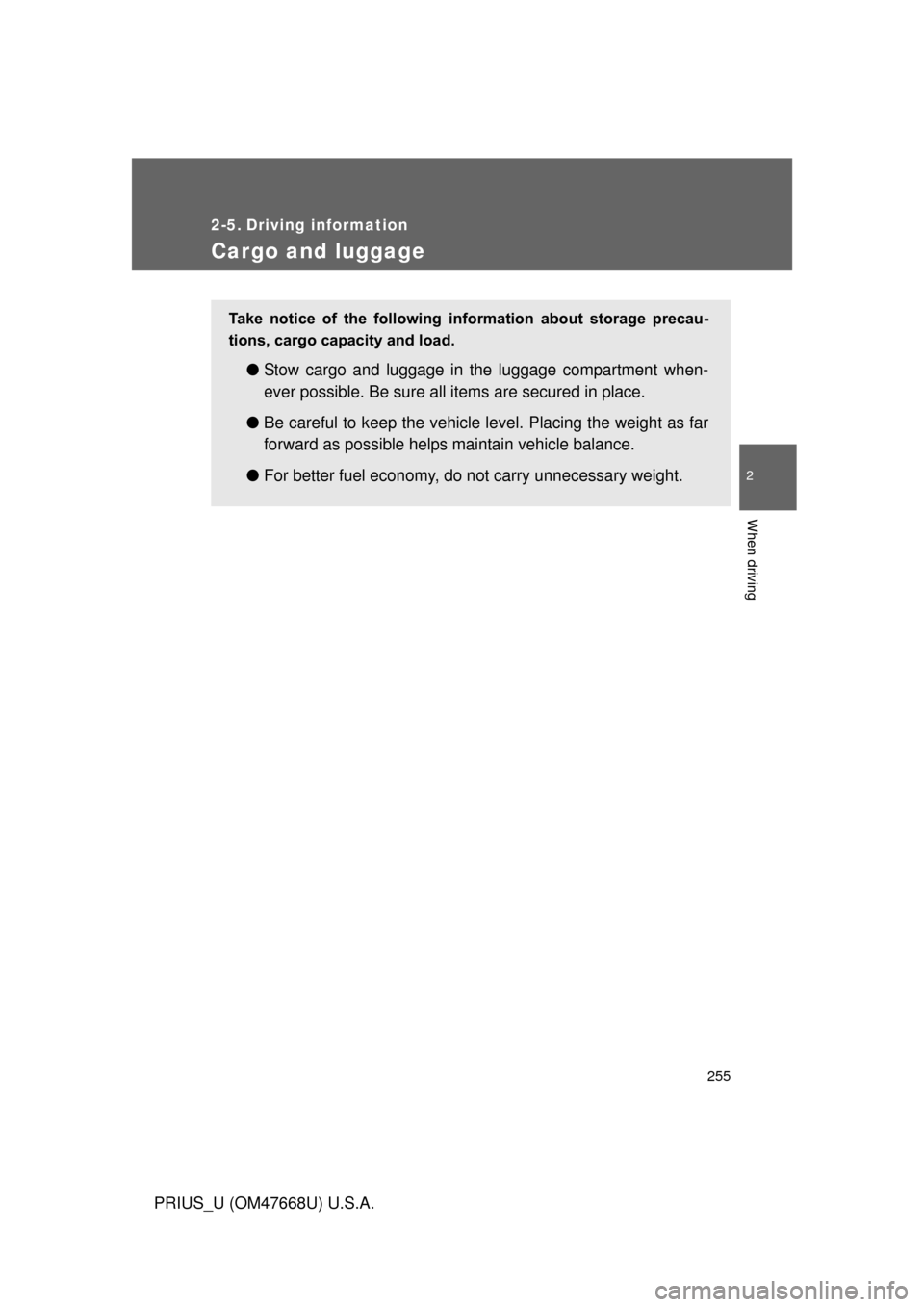
255
2
When driving
PRIUS_U (OM47668U) U.S.A.
2-5. Driving information
Cargo and luggage
Take notice of the following information about storage precau-
tions, cargo capacity and load.
●Stow cargo and luggage in the luggage compartment when-
ever possible. Be sure all items are secured in place.
● Be careful to keep the vehicle le vel. Placing the weight as far
forward as possible helps maintain vehicle balance.
● For better fuel economy, do no t carry unnecessary weight.
Page 256 of 616

256 2-5. Driving information
PRIUS_U (OM47668U) U.S.A.
Capacity and distributionCargo capacity depends on the total weight of the occupants.
(Cargo capacity) = (Total load capa city) — (Total weight of occupants)
Steps for Determining Correct Load Limit—
(1) Locate the statement “The comb ined weight of occupants and
cargo should never exceed XXX kg or XXX lbs.” on your vehi-
cle’s placard.
(2) Determine the combined weight of the driver and passengers that will be riding in your vehicle.
(3) Subtract the combined weight of the driver and passengers from
XXX kg or XXX lbs.
(4) The resulting figure equals the available amount of cargo and luggage load capacity.
For example, if the “XXX” amount equals 1400 lbs. and there will
be five 150 lb passengers in your vehicle, the amount of avail-
able cargo and luggage load capacity is 650 lbs. (1400 - 750 (5
150) = 650 lbs.)
(5) Determine the combined weight of luggage and cargo being loaded on the vehicle.
That weight may not safely exceed the available cargo and lug-
gage load capacity calculated in Step 4.
(6) If your vehicle will be towing a tr ailer, load from your trailer will
be transferred to your vehicle. C onsult this manual to determine
how this reduces the available cargo and luggage load capacity
of your vehicle. ( P. 260)
Toyota does not recommend towing a trailer with your vehicle.
Your vehicle is not designed for trailer towing.
Page 257 of 616
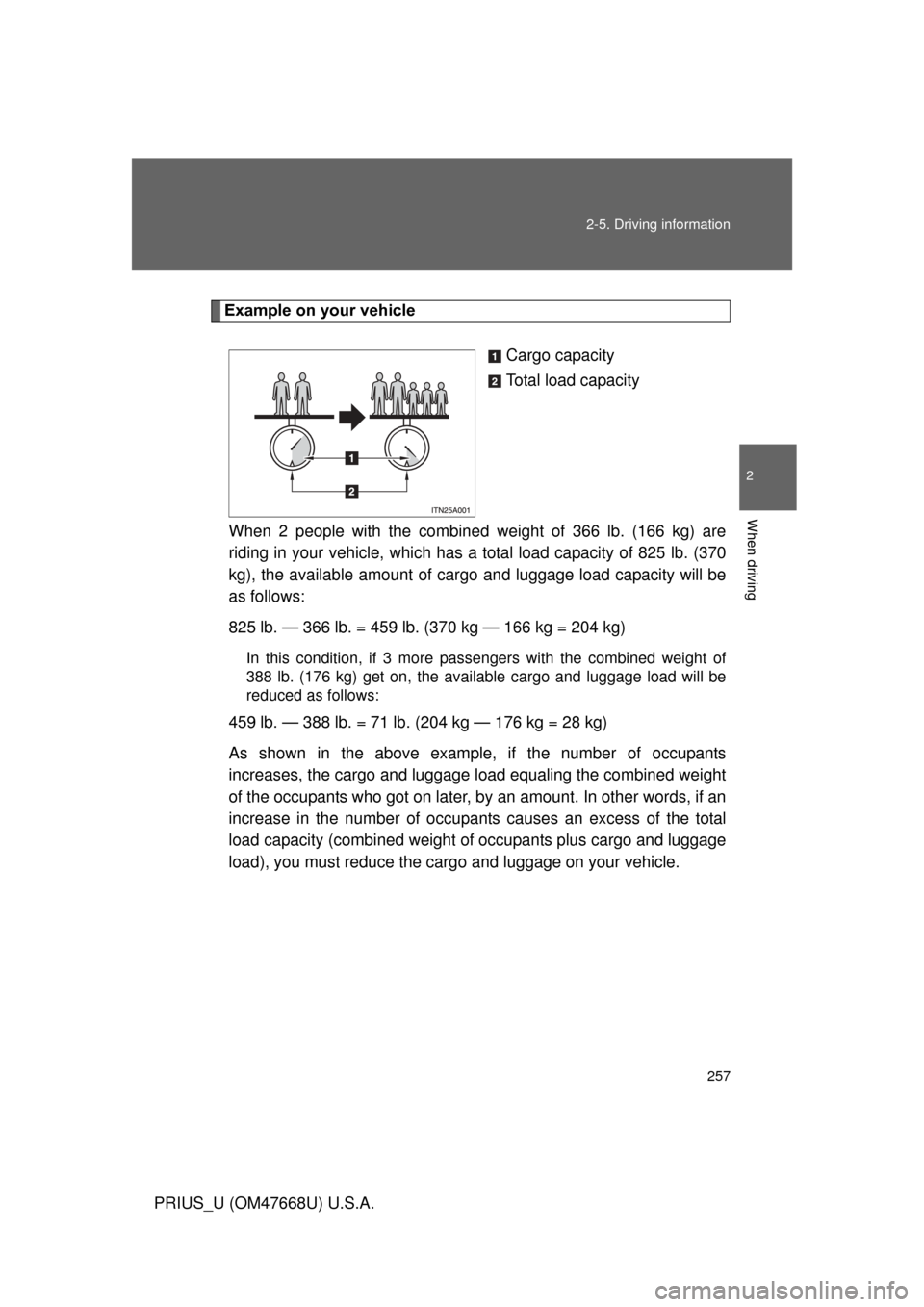
257
2-5. Driving information
2
When driving
PRIUS_U (OM47668U) U.S.A.
Example on your vehicle
Cargo capacity
Total load capacity
When 2 people with the combined weight of 366 lb. (166 kg) are
riding in your vehicle, which has a total load capacity of 825 lb. (370
kg), the available amount of cargo and luggage load capacity will be
as follows:
825 lb. — 366 lb. = 459 lb. (370 kg — 166 kg = 204 kg)
In this condition, if 3 more pass engers with the combined weight of
388 lb. (176 kg) get on , the available cargo and luggage load will be
reduced as follows:
459 lb. — 388 lb. = 71 lb. (204 kg — 176 kg = 28 kg)
As shown in the above example, if the number of occupants
increases, the cargo and luggage l oad equaling the combined weight
of the occupants who got on later, by an amount. In other words, if an
increase in the number of occupants causes an excess of the total
load capacity (combined weight of occupants plus cargo and luggage
load), you must reduce the carg o and luggage on your vehicle.
Page 258 of 616
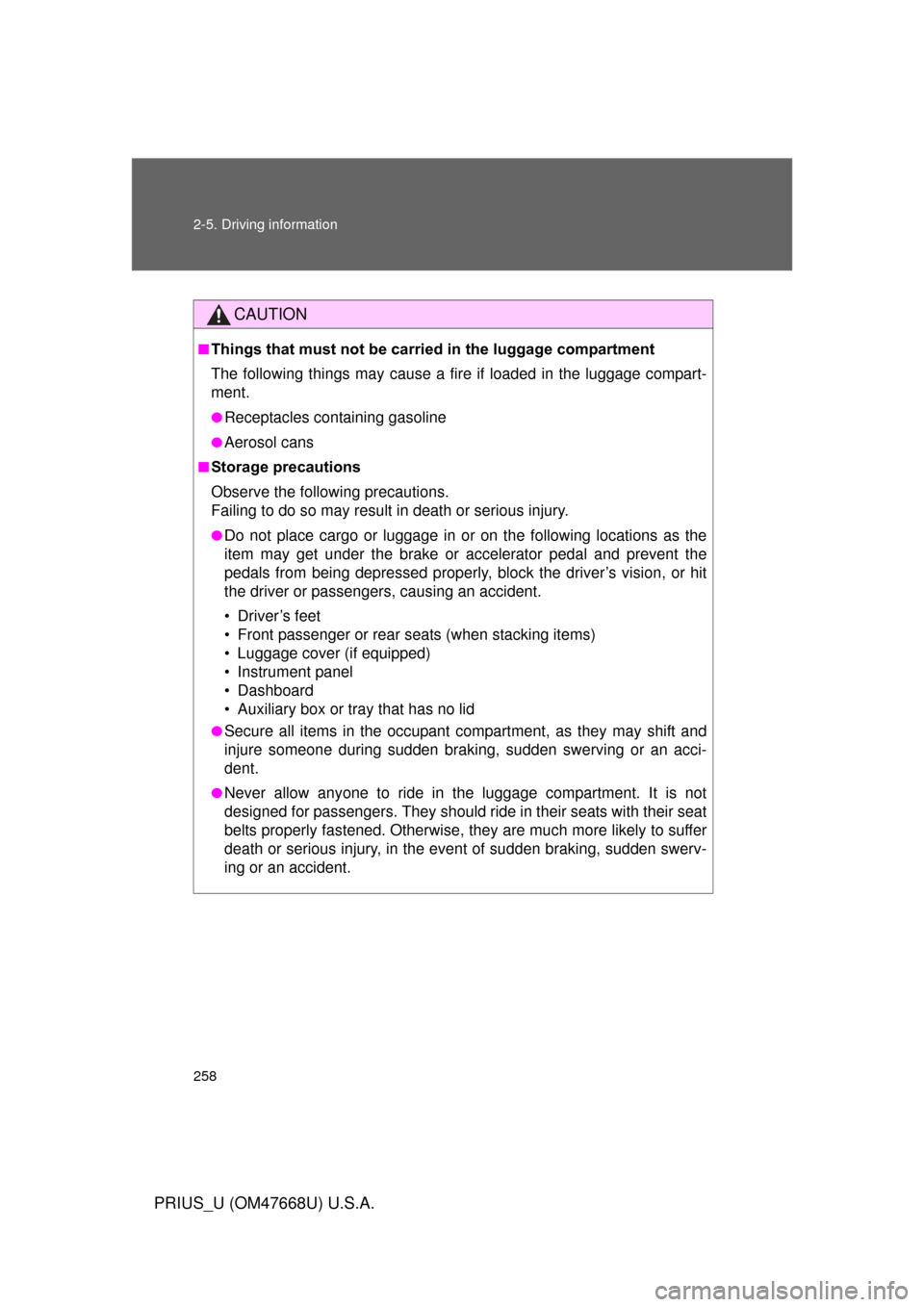
258 2-5. Driving information
PRIUS_U (OM47668U) U.S.A.
CAUTION
■Things that must not be carried in the luggage compartment
The following things may cause a fire if loaded in the luggage compart-
ment.
●Receptacles containing gasoline
●Aerosol cans
■Storage precautions
Observe the following precautions.
Failing to do so may result in death or serious injury.
●Do not place cargo or luggage in or on the following locations as the
item may get under the brake or accelerator pedal and prevent the
pedals from being depressed properly , block the driver’s vision, or hit
the driver or passengers, causing an accident.
• Driver’s feet
• Front passenger or rear seats (when stacking items)
• Luggage cover (if equipped)
• Instrument panel
• Dashboard
• Auxiliary box or tray that has no lid
●Secure all items in the occupant compartment, as they may shift and
injure someone during sudden braking, sudden swerving or an acci-
dent.
●Never allow anyone to ride in the luggage compartment. It is not
designed for passengers. They should ride in their seats with their seat
belts properly fastened. Otherwise, th ey are much more likely to suffer
death or serious injury, in the event of sudden braking, sudden swerv-
ing or an accident.
Page 259 of 616
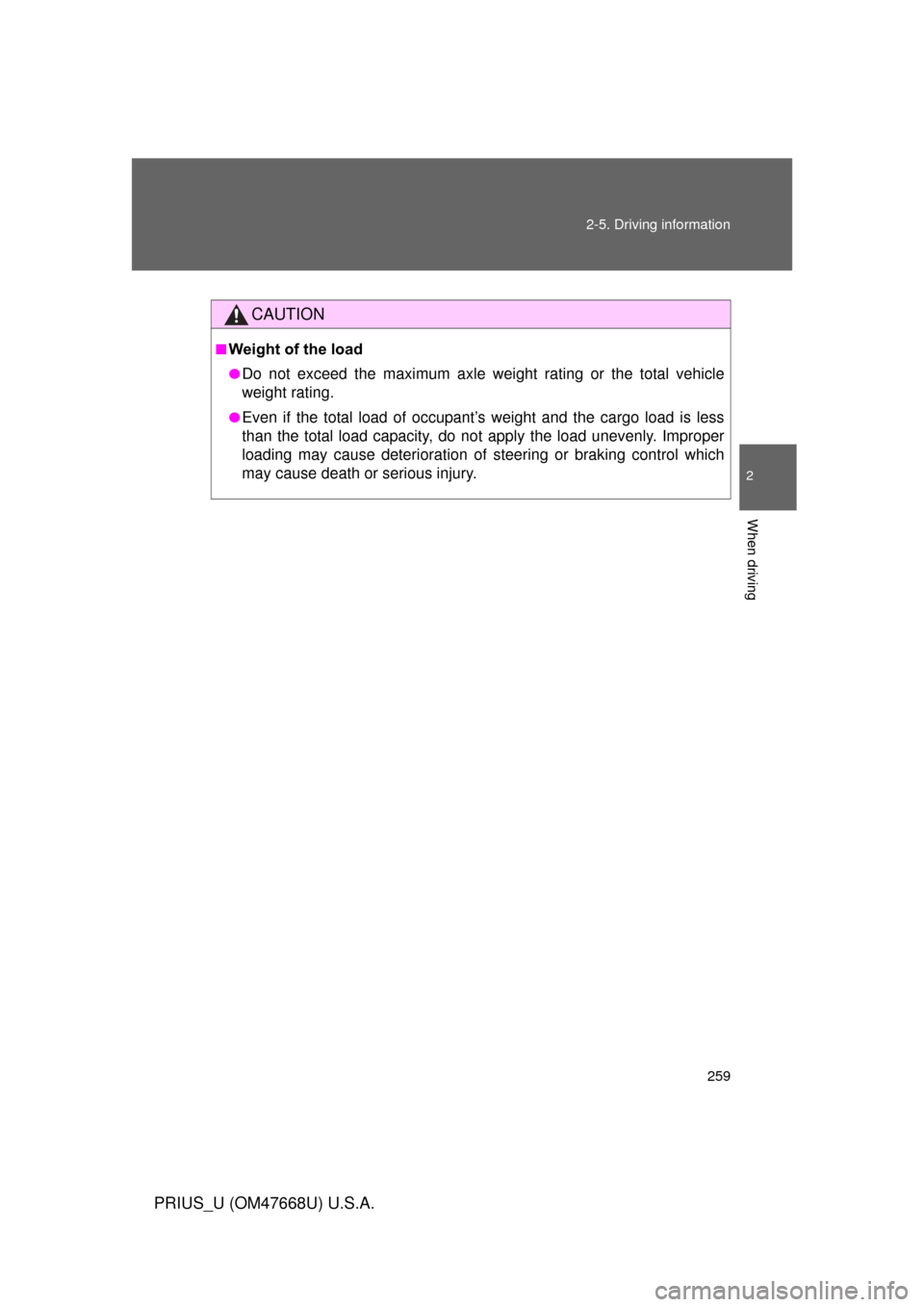
259
2-5. Driving information
2
When driving
PRIUS_U (OM47668U) U.S.A.
CAUTION
■Weight of the load
●Do not exceed the maximum axle weight rating or the total vehicle
weight rating.
●Even if the total load of occupant’s
weight and the cargo load is less
than the total load capacity, do no t apply the load unevenly. Improper
loading may cause deterioration of st eering or braking control which
may cause death or serious injury.
Page 260 of 616
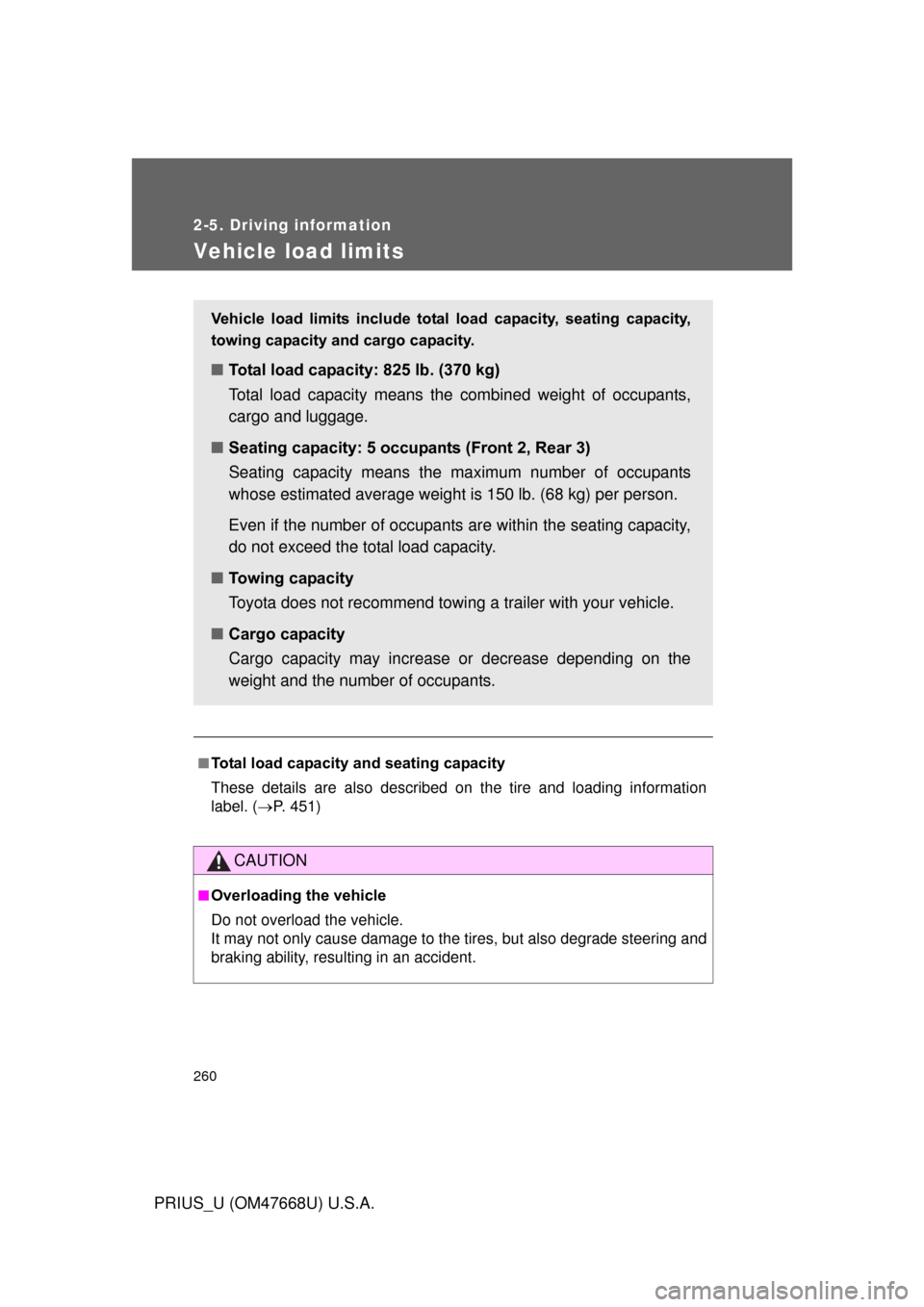
260
2-5. Driving information
PRIUS_U (OM47668U) U.S.A.
Vehicle load limits
■Total load capacity and seating capacity
These details are also described on the tire and loading information
label. (P. 451)
CAUTION
■Overloading the vehicle
Do not overload the vehicle.
It may not only cause damage to the ti res, but also degrade steering and
braking ability, resulting in an accident.
Vehicle load limits include total load capacity, seating capacity,
towing capacity and cargo capacity.
■ Total load capacity: 825 lb. (370 kg)
Total load capacity means the combined weight of occupants,
cargo and luggage.
■ Seating capacity: 5 occupants (Front 2, Rear 3)
Seating capacity means the ma ximum number of occupants
whose estimated average weight is 150 lb. (68 kg) per person.
Even if the number of occupants are within the seating capacity,
do not exceed the total load capacity.
■ Towing capacity
Toyota does not recommend towing a trailer with your vehicle.
■ Cargo capacity
Cargo capacity may increase or decrease depending on the
weight and the number of occupants.